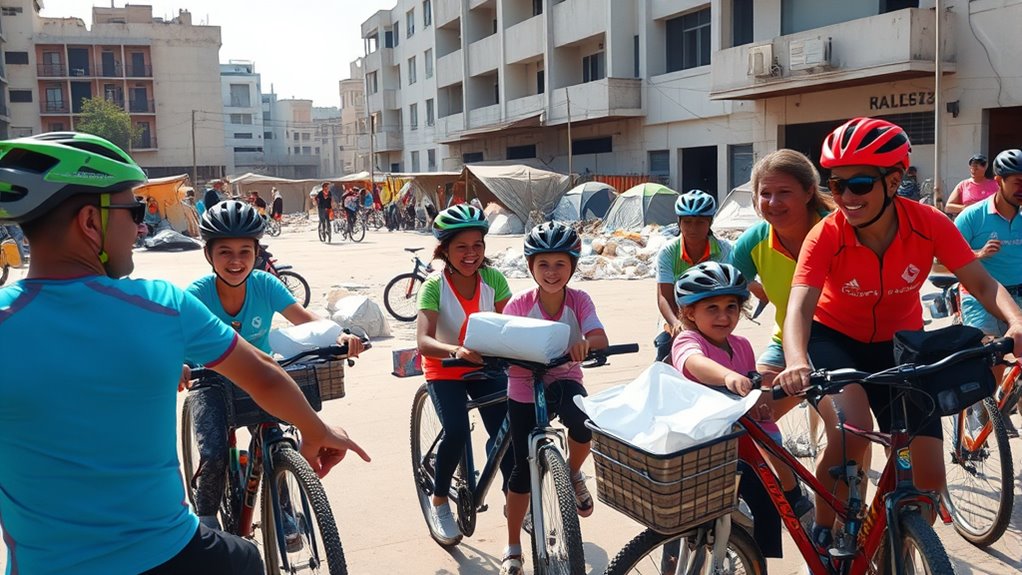Cycling is a crucial tool in disaster relief and community building because it offers quick, sustainable transportation even when roads are blocked or damaged. Bikes help you deliver supplies, access remote or crowded areas, and connect communities safely. They foster social bonds, boost resilience, and promote collective recovery efforts. If you want to discover how cycling transforms disaster responses and strengthens communities, keep exploring these innovative strategies.
Key Takeaways
- Cycling enables rapid access and delivery in disaster zones with blocked or damaged roads.
- Bicycle programs foster social cohesion and community engagement during recovery efforts.
- Cargo bikes facilitate efficient transport of supplies through debris-filled or narrow pathways.
- Integrating cycling infrastructure into disaster plans improves mobility and emergency response flexibility.
- Community cycling initiatives promote resilience, trust, and emotional well-being post-disaster.
Bicycles as Essential Tools for Rapid Deployment in Emergencies
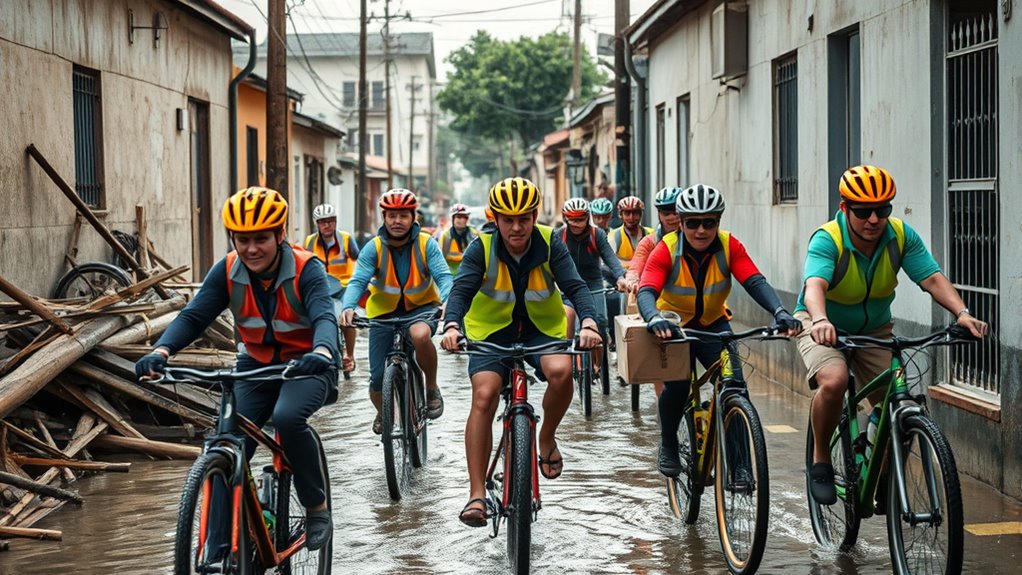
During emergencies, bicycles become essential tools because they can quickly navigate through blocked or damaged roads where vehicles might struggle. Their environmental impact is minimal, reducing pollution and conserving resources during critical times. This eco-friendly aspect helps lessen the disaster’s overall environmental footprint, supporting sustainable relief efforts.
Additionally, bicycles offer significant economic benefits; they’re affordable, require less maintenance, and don’t depend on fuel, making them cost-effective for rapid deployment. Their ability to reach affected areas swiftly enhances response times, saving lives and delivering supplies efficiently.
Overcoming Infrastructure Challenges With Bike Transportation

In disaster zones where roads are blocked or severely damaged, bicycles can be a practical solution to overcome infrastructure challenges. Cargo bikes allow you to carry essential supplies like food, water, and medicine through narrow or debris-filled paths where vehicles can’t pass.
They’re especially useful for quick deliveries in congested or impassable areas. Bike sharing programs also become essential, providing immediate access to transportation without relying on damaged infrastructure.
By setting up bike stations near shelters and aid distribution points, you enable displaced populations and relief workers to move efficiently. This approach reduces dependency on compromised roads, speeds up relief efforts, and keeps communities connected.
Enhancing Accessibility and Mobility for Displaced Populations

How can we guarantee displaced populations regain easy access to essential services amidst chaos? One way is by improving urban mobility through cycling initiatives that prioritize transportation equity. Bicycles offer flexible, affordable transportation options that overcome infrastructure damage and congestion, ensuring displaced people can reach clinics, shelters, and supplies quickly. Promoting bike-sharing programs and establishing safe cycling routes in relief zones help bridge gaps in mobility. Implementing fraud detection techniques in the coordination of relief efforts can also prevent resource misallocation and ensure aid reaches those in need efficiently.
Promoting Community Engagement and Collective Recovery
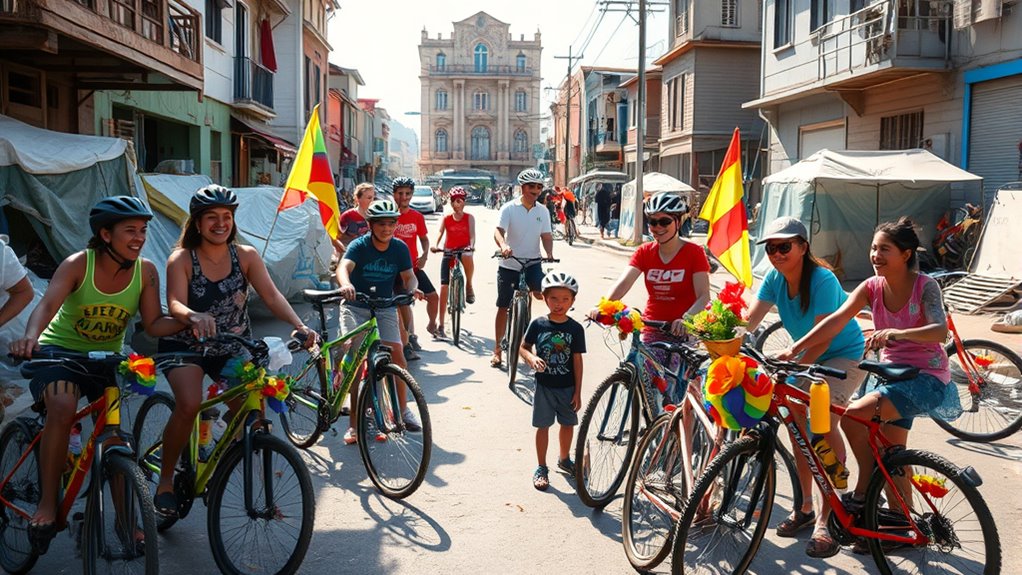
Cycling can serve as a powerful social catalyst, bringing community members together and fostering trust. Organized rides offer a safe space for neighbors to connect and share experiences. These collective efforts lay the groundwork for stronger, more resilient recovery efforts. Additionally, incorporating community-oriented activities like group cycling can enhance emotional well-being and promote a sense of unity during challenging times. Engaging in such activities can also be supported by performance metrics that track participation and impact, further strengthening community bonds. Proper preparation and safety measures ensure that these events are enjoyable and secure for all participants. Implementing low light office plants in community centers can create a welcoming atmosphere that encourages ongoing participation. Emphasizing community engagement strategies can amplify the positive effects of cycling initiatives and foster long-term resilience.
Cycling as a Social Catalyst
During disaster recovery efforts, cycling can serve as a powerful social catalyst by bringing communities together and fostering collective action. Riding together helps strengthen social cohesion, creating a sense of shared purpose and support among residents. As you cycle through affected neighborhoods, you facilitate cultural exchange, allowing diverse groups to connect, share stories, and rebuild trust. Cycling events or group rides encourage open communication and cooperation, breaking down social barriers that may have formed after a disaster. This shared experience promotes unity and resilience, making recovery efforts more effective and inclusive. Incorporating community engagement into these efforts further amplifies their positive impact on social bonds and recovery. Additionally, the community-driven nature of cycling initiatives encourages local leadership and sustained participation, vital for long-term recovery. Engaging in safe cycling practices can also help ensure that these activities remain accessible and beneficial for all community members. Promoting social cohesion through cycling can significantly enhance collective resilience in the face of future challenges. Recognizing the importance of essential oils for community health, such as lavender and eucalyptus, can also support mental and physical well-being during recovery phases.
Building Trust Through Rides
Building trust within a community often starts with shared experiences, and group rides offer a dynamic way to foster this connection. When you participate in cycling events, you create opportunities for community bonding and trust development. These rides break down social barriers, encouraging open communication and cooperation. To enhance trust through rides, consider:
- Promoting inclusive participation to guarantee everyone feels valued
- Encouraging conversations and shared goals during the ride
- Celebrating collective achievements to reinforce community spirit
- Utilizing body awareness to better understand and support diverse group members
Building Resilience Through Bicycle-Based Initiatives
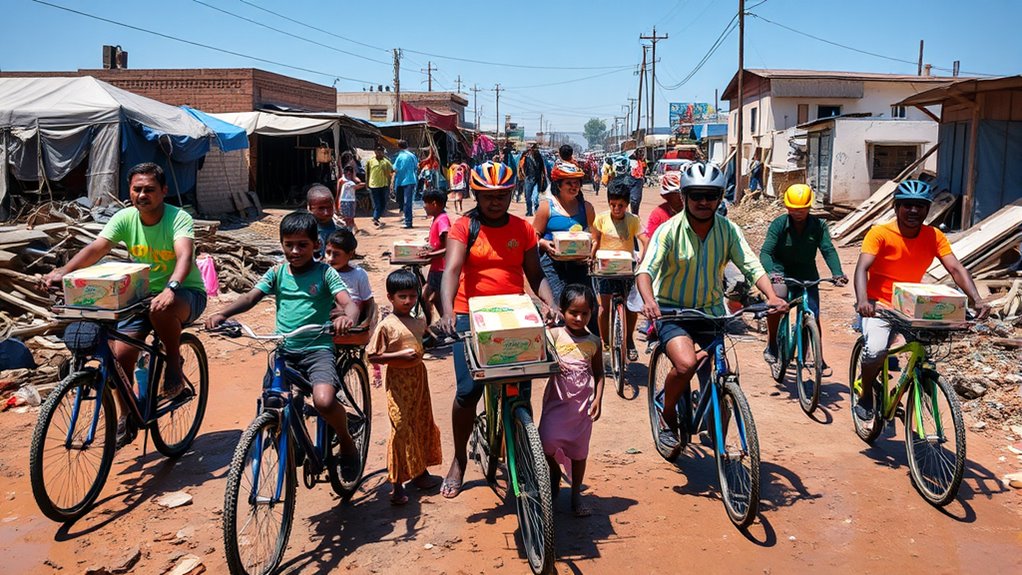
Bicycle-based initiatives have emerged as a crucial strategy for enhancing resilience in disaster relief efforts. By promoting cycling, communities strengthen urban resilience, making it easier to recover quickly from disruptions.
Bicycles provide affordable, accessible transportation that reduces dependency on damaged infrastructure, ensuring essential supplies reach those in need. Cycling also supports mental well-being, offering a healthy outlet to cope with stress and trauma during crises.
When residents actively participate in bicycle programs, they develop a sense of empowerment and community cohesion, which are vital for resilience. These initiatives foster adaptability, encouraging neighborhoods to respond proactively to challenges.
Case Studies: Successful Bicycle Relief Programs Worldwide
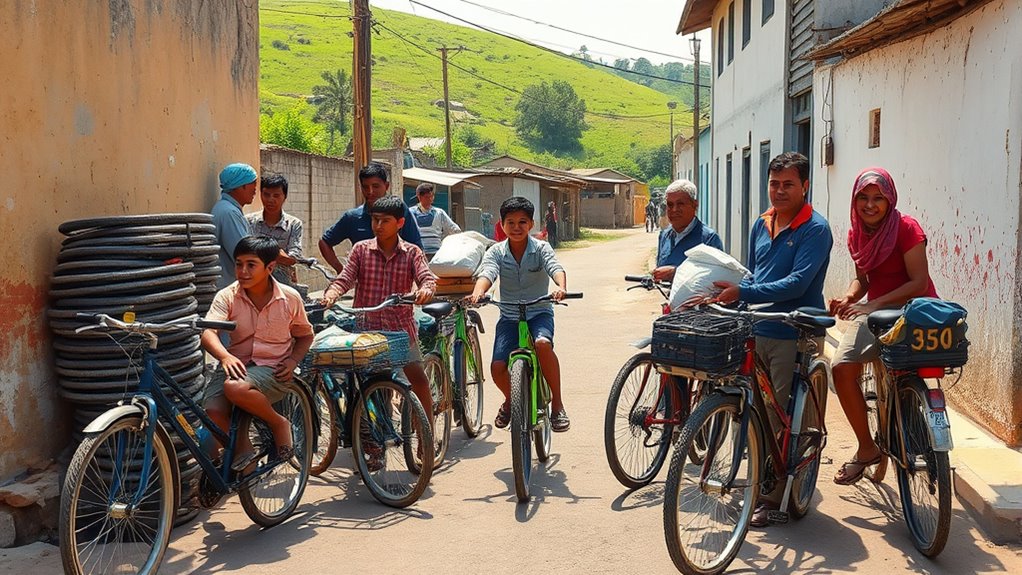
Many bicycle relief programs have markedly improved rural access, allowing communities to reach healthcare and markets more quickly. These initiatives also boost emergency response efficiency by enabling responders to navigate difficult terrain swiftly. Incorporating nutritional support such as vegetable juices into relief efforts can help improve nutrition and hydration among affected populations. Implementing sustainable transportation solutions like bicycles can ensure long-term benefits for disaster-affected communities. Recognizing the importance of community participation enhances the effectiveness and sustainability of these programs. Additionally, integrating mobile health services with bicycle programs can further extend healthcare outreach, especially in remote areas. Examining successful case studies highlights how bicycles can transform disaster relief efforts worldwide.
Rural Access Improvements
How can simple transportation solutions transform rural communities during times of disaster? Bicycle programs directly address access barriers by providing affordable, reliable rural transportation. They enable residents to reach essential services, such as healthcare, food supplies, and emergency aid, even when roads are damaged or inaccessible. Additionally, these programs promote mental health by fostering a sense of community and self-reliance among residents. Successful initiatives worldwide demonstrate that bicycles can:
- Bridge geographic and infrastructural gaps in remote areas
- Reduce dependency on costly or unavailable motorized transport
- Foster community resilience by empowering locals to respond effectively
Furthermore, the use of electric bikes can enhance mobility in challenging terrains, allowing communities to adapt quickly during disaster scenarios and recover more efficiently. Incorporating community engagement and collaborative efforts among local stakeholders further strengthens the sustainability of these programs, ensuring long-term benefits for the community. Recognizing the importance of affordable transportation options can significantly improve disaster preparedness and recovery efforts in rural settings.
Emergency Response Efficiency
When disaster strikes, efficient emergency response often hinges on rapid transportation, and bicycles have proven to be invaluable in this regard. In urban areas with heavy congestion, bikes can navigate narrow streets and traffic jams more quickly than motorized vehicles.
This agility allows responders to reach affected communities faster, delivering aid or evaluating damage efficiently. Additionally, bicycles reduce environmental impact by emitting no pollutants, making them a sustainable option during crises.
Successful programs worldwide demonstrate that cycling enhances emergency response efficiency, especially where infrastructure is compromised or inaccessible to larger vehicles.
Collaborating With Local Communities for Sustainable Impact
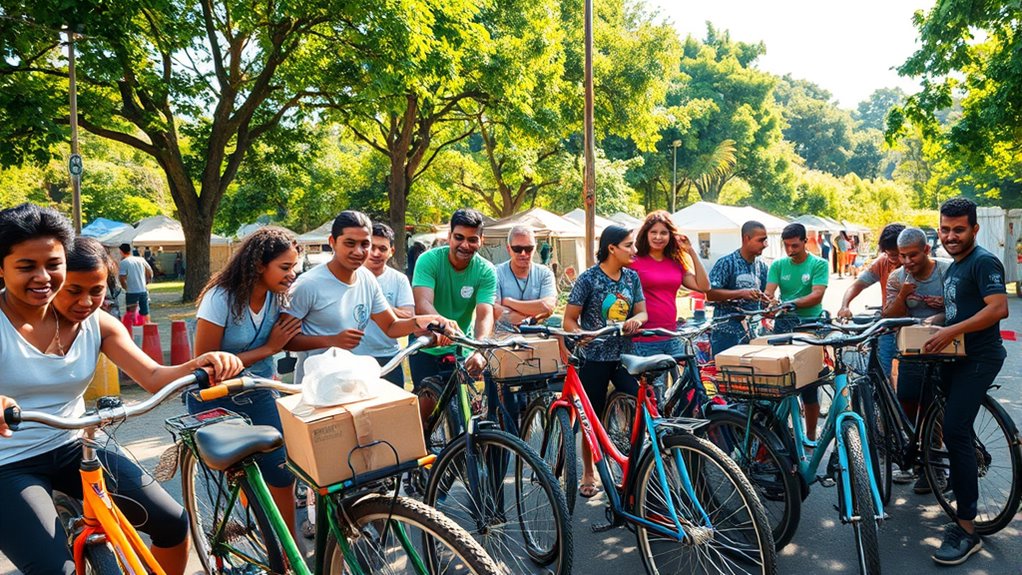
Building strong, trust-based relationships with local communities is essential for creating lasting and meaningful disaster relief efforts. When you foster genuine community participation, you empower residents to identify their needs and contribute to solutions. This approach promotes sustainable development, ensuring that relief efforts continue beyond immediate crises.
To effectively collaborate, focus on:
- Listening actively to local voices and respecting cultural contexts
- Incorporating community-led initiatives into relief plans
- Providing resources that support long-term resilience
Future Perspectives: Integrating Cycling Into Disaster Preparedness Plans

As communities strengthen their resilience through local engagement, integrating cycling into disaster preparedness plans offers a practical way to enhance mobility and response capabilities. Embracing policy integration guarantees cycling infrastructure becomes a core component of emergency strategies, while technological innovation can optimize logistics and communication. To highlight this, consider the following:
| Aspect | Benefit | Example |
|---|---|---|
| Policy Integration | Streamlines disaster response planning | Incorporating cycling routes into emergency maps |
| Technological Innovation | Improves coordination and real-time updates | GPS tracking for relief bikes |
| Community Engagement | Builds trust and ensures plan effectiveness | Training locals in cycling-based evacuation |
| Infrastructure | Enables quick, flexible mobility | Designated cycling lanes for emergencies |
Frequently Asked Questions
How Do Bicycles Improve Response Times in Densely Populated Urban Areas?
Bicycles markedly improve response times in densely populated urban areas by maneuvering through urban congestion more efficiently than cars.
With well-designed bike lane infrastructure, you can quickly bypass traffic jams, reaching emergencies faster.
This not only speeds up response efforts but also reduces congestion for other vehicles.
Your ability to steer through tight spaces makes bicycles an essential tool for rapid, reliable response, especially in crowded city environments.
What Training Is Necessary for Volunteers Using Bicycles in Disaster Zones?
You need to get trained in bike maintenance to keep your bicycle in good condition during disaster zones. Additionally, developing navigation skills is vital for efficiently reaching affected areas and avoiding obstacles.
Proper training ensures you can handle minor repairs, understand the terrain, and find the safest routes. This preparation helps you respond quickly and reliably, making a difference in emergency scenarios and helping communities recover faster.
How Do Bicycle Programs Ensure Safety for Vulnerable Populations?
To guarantee safety for vulnerable populations, bicycle programs prioritize strict safety protocols and provide protective gear like helmets, reflective vests, and gloves.
You should always follow established guidelines for riding, maintain bikes regularly, and stay alert to surroundings.
Programs also train volunteers on safe riding practices and emergency procedures, making sure everyone understands how to protect themselves and others, especially those who need extra assistance.
Can Cycling Initiatives Be Integrated With Existing Emergency Services?
You can integrate cycling initiatives with emergency services by leveraging urban logistics and volunteer coordination. Bikes offer rapid response in congested areas, ensuring faster delivery of supplies and aid.
By organizing volunteers with clear roles and communication, you optimize efficiency. This approach enhances disaster relief efforts, making emergency response more agile and community-focused.
Cycling becomes a crucial tool, seamlessly blending into existing services to save lives and rebuild communities effectively.
What Funding Sources Support Bicycle-Based Disaster Relief Projects?
You can secure funding for bicycle-based disaster relief projects through various sources. Funding grants from government agencies, non-profit organizations, and international aid programs often prioritize innovative community solutions.
Charitable donations also play a vital role, as individuals and businesses support initiatives that promote resilience and mobility. By leveraging these funding sources, you can develop and sustain projects that enhance disaster response and strengthen community bonds through cycling.
Conclusion
Think of cycling as the heartbeat of disaster relief—pumping life into communities when every second counts. By embracing bicycles, you become part of a resilient network that quickly adapts and heals. These two-wheeled allies aren’t just tools; they’re bridges connecting hope and recovery. As you support and implement cycling initiatives, you help turn chaos into clarity, forging pathways toward a stronger, more unified future where every pedal stroke rebuilds trust and resilience.
